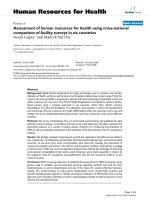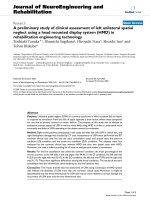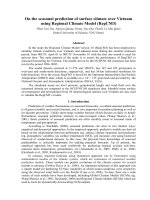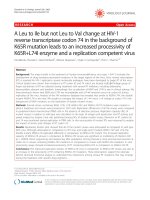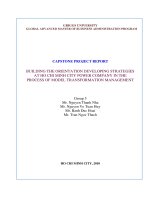Assessment of water availability at growth stages of rainfed Kharif rice in the plains of west bengal during 2020-2099 using regional climate model output
Bạn đang xem bản rút gọn của tài liệu. Xem và tải ngay bản đầy đủ của tài liệu tại đây (406.74 KB, 10 trang )
Int.J.Curr.Microbiol.App.Sci (2019) 8(4): 2398-2407
International Journal of Current Microbiology and Applied Sciences
ISSN: 2319-7706 Volume 8 Number 04 (2019)
Journal homepage:
Original Research Article
/>
Assessment of Water Availability at Growth Stages of Rainfed kharif
Rice in the Plains of West Bengal during 2020-2099 using
Regional Climate Model Output
S. Mahato1*, A. Saha1 and D. Majumder2
1
Department of Agricultural Meteorology, 2Department of Agricultural Statistics,
BCKV, West Bengal, India
*Corresponding author
ABSTRACT
Keywords
Rainfall, Stable
rainfall, Standard
Meteorological
Week (SMW), Rice
Article Info
Accepted:
17 March 2019
Available Online:
10 April 2019
An attempt has been made in the present paper to study the agroclimatic potential for the
future periods from 2020 to 2099 with A1B-GHG ( Greenhouse Gas Emissions Scenarios)
emission scenarios which have been derived from PRECIS (Providing Regional Climate
for impact Studies). Rainfall data was used to estimate decadal change in the stable rainfall
at various growth stages of transplanted rice of five different representative stations
pertaining to Terai, Old Alluvial, New Alluvial, Red & Laterite, and Coastal Saline zones
of West Bengal. Rainfall information was also utilized for determining earliest date for
sowing upland crop and transplanted rice. Decadal averages of various agroclimatic
indices were tested through Analysis of variance (ANOVA) for discovering significant
differences. Analysis showed that distribution of stable rainfall over various growth stages
of rice though showed a distinct reduction with advancement of transplanting time for 29
SMW to 35 SMW, relative differences of such resources over the future decades were
inconsistent.
Introduction
Crop planning, particularly under rainfed
condition, need thorough appraisal of the
agroclimatic resources in general and rainfall
and resultant crop water availability, in
particular. Since such planning varies with
locale and soil physical factors, a uniform
plan cannot be advocated for a large region,
like the plains of West Bengal. So, separate
appraisal for each agroclimatic zones is very
much needed. There are many literatures that
have already been conducted using historical
meteorological records which are suitable for
assessment of the present climatic situation
and its potential for Rice productivity.
However, as the threat of climate change
looming large in the horizon, these
assessments may not be sufficient for the
future periods, for which assessment of Rice
production is very urgent. With the advent of
various Global Circulation Models (GCMs)
and Regional Circulation Models (RCMs),
synthetic future daily weather data on various
parameters are available for the entire global
region, at very narrow coordinates even up to
the end of this century.
2398
Int.J.Curr.Microbiol.App.Sci (2019) 8(4): 2398-2407
The climate in the state of West Bengal is
tropical and humid except in the northern
hilly region. The average rainfall in the state
is about 1750 mm. (NABARD, 2014). 7580% of the rainfall occur during the four
months i.e., within June to September of the
monsoon season, followed by four to five
months dry period during November to March
with having very low rainfall for crop
production. Crop production during pre-kharif
season i.e., February to May with jute and aus
rice sown during mid-April to May may not
be successful when there is delay in the onset
of monsoon. The state as a whole, experiences
dry sub-humid to humid climate. The warm
rainy season is climatically suited to most
tropical crops like rice, jute etc. (Ghosh,
1991).
Projections of rainfall in West Bengal for mid
century i.e 2050s indicates that there is no
change in monsoon (June-July-AugustSeptember) rainfall in the entire region,
except, an increase is indicated in the
southern Sundarbans region of the South 24
Parganas and in Eastern part of Purulia. In the
winters
(October-November-December),
however, the scenario changes, the rainfall
decreases in most parts of southern Bengal,
no change is seen in eastern parts of Purulia
and in Coochbehar and Jalpaiguri. In
summers, the rainfall is likely to decrease
northwards starting from Bankura, Purulia,
Burdwan, with no change in Paschim
Medinipur, Hooghly, Howrah, and North 24
Parganas, and an increase in summer rainfall
in the south 24 Parganas and Uttar Medinipur.
The rainfall however tends to increase in the
entire region by the end of the century, except
in January-February period, when the rainfall
is likely to decrease in the entire alluvial
region from Dakshin Dinajpur in the north to
Bankura, Howrah, Kolkata, and northern parts
of North 24 Parganas and Paschim Medinipur
in the South (Anon, 2013).
Materials and Methods
Climate projections from 2020 through 2099
have been derived from PRECIS (Providing
Regional Climate for Impact Studies), which
is portable version of the HadCM3 model,
developed to run with a grid resolution of
0.44° x 0.44° (Jones et al., 2004). The climate
change scenarios are driven by the GHG
emission scenarios-A1B. For each climate
grid daily data on rainfall, minimum
temperature, maximum temperature, solar
radiation, relative humidity and wind speed
were available in the dataset. Five
representative locations each from one
agroclimatic region, viz., Terai (Jalpaiguri),
Old alluvial (Raiganj), new alluvial
(Krishnanagar), Red & Laterite (Purulia) and
Coastal saline zone (Canning) in the plains of
West Bengal were selected for analysis.
Data analysis
The climatological analyses in this study were
on Standard Meteorological Week (SMW)
basis. To make the period 1st January to 7th
January each year as 1st SMW, an adjustment
was made in the said table. In this week
format, the 9th SMW would consist of 8 days
from 26th February to 4th March in the leap
years, however, in other years it would consist
of 7 days. Last week of the year, 52nd SMW,
would always consist of 8 days (24th
December to 31st December).
Stable rainfall for rice
Considering 3-4 mm daily ET loss and 3-4
mm daily percolation loss from rice field in
the eastern Indian region, Singh and Singh
(2000) have assumed that a weekly rainfall of
50 mm is sufficient / stable to meet the water
requirement of rice crop. Since the average
bund height maintained by the farmer is
around 50 mm, which is maximum allowable
submergence, it was considered that any
2399
Int.J.Curr.Microbiol.App.Sci (2019) 8(4): 2398-2407
weekly rainfall above this quantity is
ineffective and is going to be lost as run-off
(Saha, 2006). Taking this into consideration,
effective rainfall (50 mm/week) for each
week of kharif rice crop growing season of
the entire database was calculated. Entire
growth period of rice after transplanting was
divided into three stages, viz., vegetative (6
weeks), reproductive (4 weeks) and maturity
(4 weeks). However, during maturity stage
rainwater deficit was analyzed only up to 3
weeks since later weeks require dryness for
good harvesting operation. Cumulative stable
rainfall for each of the three crop growth
stages, were summed up for 5 different
possible transplanting periods (29th, 31st, 33rd
and 35th SMW).
Statistical analysis
Decadal trends
To compare the decadal trends of various
parameters, data corresponding to 8 decades
like
2020-29,
2030-2039
etc
were
summarized and compared using one way
analysis of variance. “F” values were tested
for significance and SE (m) and L.S.D. (5%
level) values were calculated, corresponding
to each parameter, using standard statistical
methods.
Results and Discussion
Decadal changes in the stable rainfall at
various growth stages of transplanted rice
Accumulated stable rainfall during vegetative,
reproductive, maturity as well as during entire
growing stage for the rainfed kharif rice crop
transplanted from 29 to 35 Standard
Meteorological Week (SMW), averaged over
decades from 2020s through 2090s for
different agroclimatic zones of West Bengal
are presented in Tables 1, 2, 3, 4.
During vegetative stage, the decadal averages
of stable rainfall were not found to be much
variable and statistically significant. During
vegetative stage, against a stable rainfall
requirement of 300 mm for 6 weeks period,
the agroclimatic zones are likely to receive
around 220 to 297 mm across various
transplanting weeks and different future
periods up to 2099. If the crop is transplanted
up to 33 SMW, it is likely to receive
maximum stable rainfall in Terai region
which is followed by Red and Laterite and
Coastal saline zone and least amount will be
available in Old and New alluvial zone. With
delay in transplanting from 29 SMW, there is
a slight reduction in stable rainfall up to 33
SMW and the reduction is steeper when the
transplanting is delayed up to 35 SMW. If the
transplanting is extended up to 31st SMW, the
vegetative stage of the crop is likely to be
affected most by deficit of stable rainfall in
the Red and Laterite zones of West Bengal.
Though there is little variation in the decadal
averages of the stable rainfall during this
period, no definite trends with the
advancement of the decade towards 2090s
were confirmed.
If transplanted during 29 SMW (July 16 to
22), the reproductive stage of rice crop is
most likely to receive rainfall which is very
near to its optimum requirement of 200 mm
and the extent of reduction, if any, may be to
the extent of 25%. The status of such water
availability pattern is consistent among the
entire agroclimatic zones studied for entire
future decades from 2020s to 2090s. If the
transplanting is delayed up to 31 SMW (July
31 to Aug 5), the extent of reduction of stable
rainfall can maximum be a nominal rate of
25%, which is consistent across the
agroclimatic zones in future decades.
Therefore, data presented in the tables
revealed that transplanted rice in different
agroclimatic zones of West Bengal will be
almost free from water stress during
2400
Int.J.Curr.Microbiol.App.Sci (2019) 8(4): 2398-2407
reproductive stage for all the future decades
up to 2090s. If the transplanting is delayed by
another fortnight, that is 33 SMW (Aug 13rd
to 19th Aug) a reduction in stable rainfall to
the extent of 25% to 50 % (against 200 mm
ideal for the stage) can be obtained during
various future decades across all agroclimatic
zones studied. However, the extent of
reduction due to such delay is likely to be
much higher in Red and Laterite zone as
compared to that in other agroclimatic zones.
However, under situation of extreme late
transplanting at 35 SMW the extent of
reduction in the stable rainfall availability is
likely to be reduced to be 50% to 85% across
all the agroclimatic zones and future decades
with the extents of such reduction are steeper
in Red and Laterite zone. There found to be a
little variation in the decadal averages of the
stable rainfall during this period but in most
of the cases no definite trend with the
advancement of the decade towards 2090s
were confirmed.
Under complete rainfed condition the
maturity stage of rice crop will definitely
receive reduced stable rainfall across the
agroclimatic zones and over future decadal
periods. When the crop is transplanted up to
31 SMW, the extent of shortage in stable
rainfall during this stage is likely to the tune
of 15 to 50% but, if the transplanting is
further delayed up to 33 SMW (13rd Aug to
19th Aug) or 35 SMW (Aug 27th to 2nd Sep)
the extent of stable rainfall shortage may be to
the tune of 80 to 95 % and it is consistent
across agroclimatic zones and future decades.
Decadal averages of stable rainfall during this
stage did not show any significant trend over
the future period up to 2090s.
When the decadal changes of the total stable
rainfall during the growing season of rice
were compared, it was revealed that the
decadal variation was statistically significant
for all possible transplanting scenarios up to
35 SMW in Terai zone of West Bengal. The
decade of 2080s is likely to receive highest
stable rainfall which is statistically different
from that of first three decades up to 2040s.
However, decadal trend were statistically at
par for rest of the agroclimatic zones studied.
If transplanted during 29 SMW, rice crop, in
its entire growth period, likely to receive
shortage of stable rainfall only to the extent of
6 to 25 % which is increased up to 13 to 33%
for transplanting on 31 SMW, 25 to 45% for
33 SMW and 42 to 57% when transplanting is
delayed extremely up to 35 SMW. The
variation of the stable rainfall over the
decades for different growth stages of Rice
are plotted on Figure 1.
Considering stage wise availability of stable
rainfall of different growth stages of
transplanted rice, it was revealed from the
above tables that the amount of rain water
deficit is in the order, maturity stage >
reproductive stage > vegetative stage. When
studied across agroclimatic zones, it is evident
that pattern of relative water deficit during
different stages with delay in transplanting is
almost similar which indicates similar
temporal pattern of rain fall distribution
during crop growth stages across the
agroclimatic zones studied.
Considering the criteria of weekly stable
rainfall as described by Singh and Singh
(2000), Saha (2006) estimated stable rainfall
for rice under different transplanting scenario
for various locations of New Alluvial zone of
West Bengal using historical database of
rainfall at different climatic risk level which
also showed similar temporal pattern of stable
rainfall
availability
under
different
transplanting scenario.
2401
Int.J.Curr.Microbiol.App.Sci (2019) 8(4): 2398-2407
Table.1 Decadal change of stable rainfall (mm) during vegetative stage of rice transplanted in
different meteorological weeks (Kharif) in the agroclimatic zones of West Bengal
Decades
Terai Zone
Old Alluvial Zone
29SMW 31SMW 33SMW 35SMW 29SMW 31SMW 33SMW 35SMW
295.6
299.1
295.9
272.9
257.5
263.0
268.8
249.6
2020s
295.3
292.2
293.7
272.4
265.3
266.4
277.0
252.7
2030s
297.6
294.4
291.9
267.2
262.2
258.9
264.3
243.0
2040s
296.0
298.7
294.3
291.0
261.3
262.5
262.9
268.1
2050s
298.2
297.6
293.6
284.5
264.3
261.1
256.0
259.5
2060s
285.1
289.1
292.1
277.0
241.6
259.0
265.6
261.8
2070s
297.8
295.8
295.8
290.5
265.4
255.4
265.6
262.4
2080s
296.4
295.4
292.2
279.9
252.5
262.1
268.1
253.7
2090s
SE(m)
LSD(0.05)
3.0
NS
Decades
2020s
2030s
2040s
2050s
2060s
2070s
2080s
2090s
SE(m)
LSD(0.5)
29SMW
246.4
263.9
259.5
252.7
240.3
248.3
253.1
251.5
12.5
NS
2.5
NS
3.0
NS
6.6
NS
8.8
NS
8.1
NS
7.7
NS
9.7
NS
New Alluvial Zone
Red and laterite Zone
31SMW 33SMW 35SMW 29SMW 31SMW 33SMW 35SMW
238.2
245.4
234.3
278.5
266.0
256.3
228.1
254.3
260.1
237.3
279.1
270.4
267.2
227.9
241.5
244.0
232.8
281.5
266.2
260.0
227.2
252.3
235.7
231.8
278.0
273.8
248.5
237.9
240.3
237.8
236.4
261.4
260.8
251.2
226.3
261.3
265.5
241.4
283.1
288.0
279.5
238.5
231.2
234.1
234.0
280.3
257.5
260.3
236.5
242.0
235.7
220.3
272.7
251.4
247.3
227.0
12.1
NS
12.5
NS
Decades
29SMW
274.5
2020s
281.7
2030s
274.0
2040s
281.2
2050s
274.2
2060s
279.1
2070s
278.4
2080s
276.0
2090s
6.5
SE(m)
NS
LSD(0.05)
12.6
NS
8.3
NS
9.2
NS
Coastal Saline Zone
31SMW 33SMW 35SMW
268.0
266.7
242.9
280.7
280.8
257.9
264.6
270.5
243.2
280.7
266.8
263.5
269.9
257.4
242.7
283.4
281.1
248.4
266.3
268.3
253.6
270.0
261.3
239.8
6.8
8.2
10.8
NS
NS
NS
2402
10.0
NS
13.4
NS
Int.J.Curr.Microbiol.App.Sci (2019) 8(4): 2398-2407
Table.2 Decadal change of stable rainfall (mm) during reproductive stage of rice transplanted in
different meteorological weeks (Kharif) in the agroclimatic zones of West Bengal
Decades
Terai Zone
Old Alluvial Zone
29SMW 31SMW 33SMW 35SMW 29SMW 31SMW 33SMW 35SMW
196.0
173.6
110.1
48.2
178.7
164.6
98.4
43.1
2020s
193.9
176.3
114.8
48.9
181.6
166.8
106.5
48.9
2030s
193.3
170.4
106.6
42.5
177.5
158.3
95.4
35.2
2040s
195.0
191.0
127.2
54.9
176.3
182.3
123.1
52.7
2050s
194.9
185.5
140.6
70.6
178.3
169.6
128.5
63.4
2060s
192.6
177.2
145.1
84.1
181.0
168.6
142.0
88.1
2070s
197.4
193.2
148.0
78.6
178.0
183.2
128.2
58.1
2080s
195.0
180.9
134.9
67.0
176.8
165.2
122.5
58.4
2090s
SE(m)
LSD(0.05)
2.8
NS
Decades
2020s
2030s
2040s
2050s
2060s
2070s
2080s
2090s
SE(m)
LSD(0.05)
29SMW
166.7
169.1
164.8
154.2
164.3
177.0
158.6
145.6
9.7
NS
6.4
NS
10.9
30.83
11.3
NS
6.0
NS
8.3
NS
12.2
NS
11.3
NS
New Alluvial Zone
Red and laterite Zone
31SMW 33SMW 35SMW 29SMW 31SMW 33SMW 35SMW
156.0
107.5
59.1
167.8
142.2
84.6
46.9
157.7
109.2
58.1
172.2
140.8
86.5
48.1
155.8
106.6
49.9
169.8
144.2
88.1
38.6
146.5
115.0
58.6
161.7
148.9
104.9
46.5
150.3
118.7
67.3
166.4
135.6
94.6
48.3
146.3
128.3
92.2
181.3
140.5
98.7
65.5
164.6
127.5
71.2
169.3
160.9
97.8
46.4
148.5
124.4
76.0
155.5
153.5
119.3
62.7
10.4
NS
12.7
NS
10.8
NS
8.9
NS
11.9
NS
Decades
Coastal Saline Zone
2020s
2030s
2040s
2050s
2060s
2070s
2080s
2090s
SE(m)
LSD(0.05)
29SMW 31SMW 33SMW 35SMW
181.4
153.2
103.0
64.5
185.7
165.4
110.3
53.8
180.3
155.8
103.1
54.9
177.4
166.5
126.2
61.8
171.1
150.5
120.2
68.2
183.1
152.5
125.7
89.1
176.3
169.3
125.6
69.4
165.6
155.8
126.6
76.6
6.8
9.8
13.3
11.1
NS
NS
NS
NS
2403
15.2
NS
11.2
NS
Int.J.Curr.Microbiol.App.Sci (2019) 8(4): 2398-2407
Table.3 Decadal change of stable rainfall (mm) during maturity stage of rice transplanted in
different meteorological weeks (Kharif) in the agroclimatic zones of West Bengal
Decades
Terai Zone
Old Alluvial Zone
29SMW 31SMW 33SMW 35SMW 29SMW 31SMW 33SMW 35SMW
94.3
38.8
19.9
17.4
83.7
32.7
22.5
24.5
2020s
101.7
43.0
14.7
9.2
94.4
41.6
14.8
6.9
2030s
90.6
35.8
10.4
7.3
84.8
33.0
6.4
11.2
2040s
119.2
53.4
28.9
10.7
111.3
51.0
27.1
15.1
2050s
124.2
64.9
24.4
16.9
114.5
56.3
26.1
23.2
2060s
122.6
70.9
34.8
16.7
116.7
71.1
34.1
16.8
2070s
126.6
73.5
30.2
10.0
108.4
55.5
20.7
10.0
2080s
116.9
63.3
18.4
4.0
107.5
54.7
16.0
6.2
2090s
SE(m)
LSD(0.05)
8.5
23.85
Decades
2020s
2030s
2040s
2050s
2060s
2070s
2080s
2090s
SE(m)
LSD(0.05)
29SMW
91.4
94.0
95.1
98.7
106.7
102.3
105.7
104.7
10.7
NS
10.8
NS
6.1
NS
4.8
NS
10.1
NS
10.5
NS
6.6
NS
6.5
NS
New Alluvial Zone
Red and laterite Zone
31SMW 33SMW 35SMW 29SMW 31SMW 33SMW 35SMW
52.7
29.6
25.3
75.4
38.0
31.0
22.3
50.2
18.3
2.9
77.1
40.1
19.0
4.2
44.1
14.9
16.3
77.1
37.3
9.3
7.9
55.7
27.0
12.0
89.6
44.8
22.9
10.4
58.5
25.4
18.4
85.9
43.5
19.7
18.3
74.9
37.4
21.6
80.6
49.2
29.1
12.4
67.6
30.4
19.6
81.5
43.4
22.1
14.3
72.1
29.7
8.9
105.9
61.9
16.3
9.2
9.7
NS
7.6
NS
Decades
29SMW
86.9
2020s
95.7
2030s
89.2
2040s
108.6
2050s
105.0
2060s
102.5
2070s
101.0
2080s
109.4
2090s
10.6
SE(m)
NS
LSD(0.05)
6.1
NS
12.5
NS
10.4
NS
Coastal Saline Zone
31SMW 33SMW 35SMW
54.4
31.8
19.1
46.4
17.4
14.9
49.0
21.4
18.0
57.4
23.7
13.2
58.2
23.9
18.3
71.2
38.4
20.3
64.1
30.0
18.1
73.8
29.0
10.3
9.8
7.3
6.3
NS
NS
NS
2404
6.6
NS
5.8
NS
Int.J.Curr.Microbiol.App.Sci (2019) 8(4): 2398-2407
Table.4 Decadal change of stable rainfall (mm) during whole growing stage of rice transplanted
in different meteorological weeks (Kharif) in the agroclimatic zones of West Bengal
Decades
Terai Zone
Old Alluvial Zone
29SMW 31SMW 33SMW 35SMW 29SMW 31SMW 33SMW 35SMW
585.9
511.5
425.8
338.4
519.9
460.3
389.7
317.2
2020s
590.9
511.5
423.2
330.5
541.2
474.7
398.2
308.4
2030s
581.5
500.5
408.9
317.0
524.4
450.3
366.1
289.3
2040s
610.2
543.1
450.4
356.6
549.0
495.8
413.0
335.8
2050s
617.3
547.9
458.5
372.1
557.1
487.0
410.7
346.0
2060s
600.4
537.3
472.1
377.7
539.2
498.7
441.6
366.7
2070s
621.8
562.5
474.0
379.1
551.8
494.2
414.5
330.5
2080s
608.3
539.6
445.5
350.8
536.8
482.0
406.6
318.2
2090s
SE(m)
LSD(0.05)
9.1
25.68
Decades
2020s
2030s
2040s
2050s
2060s
2070s
2080s
2090s
SE(m)
LSD(0.05)
29SMW
504.4
526.9
519.4
505.6
511.3
527.7
517.3
501.7
22.4
NS
13.1
37.03
22.0
62.1
14.3
40.3
15.5
NS
16.3
NS
17.1
NS
16.8
NS
New Alluvial Zone
Red and laterite Zone
31SMW 33SMW 35SMW 29SMW 31SMW 33SMW 35SMW
446.8
382.5
318.7
521.7
446.2
371.9
297.3
462.2
387.5
298.3
528.4
451.2
372.7
280.1
441.4
365.5
298.9
528.4
447.6
357.4
273.5
454.5
377.7
302.2
529.3
467.6
376.2
294.7
449.1
381.8
322.1
513.6
439.9
365.5
292.8
482.5
431.2
355.1
545.0
477.7
407.3
316.4
463.3
391.9
324.7
531.1
461.8
380.2
297.2
462.6
389.9
305.2
534.1
466.7
382.9
298.9
21.9
NS
22.1
NS
Decades
29SMW
542.7
2020s
563.1
2030s
543.5
2040s
567.1
2050s
550.3
2060s
564.7
2070s
555.7
2080s
551.0
2090s
16.8
SE(m)
NS
LSD(0.05)
20.5
NS
18.3
NS
21.1
NS
Coastal Saline Zone
31SMW 33SMW 35SMW
475.6
401.5
326.5
492.5
408.4
316.6
469.3
395.0
316.1
504.6
416.8
338.5
478.6
401.4
329.2
507.0
445.2
357.7
499.6
423.9
341.0
499.6
417.0
326.7
18.8
19.7
19.3
NS
NS
NS
2405
21.7
NS
20.6
NS
Int.J.Curr.Microbiol.App.Sci (2019) 8(4): 2398-2407
Fig.1 Decadal variation of the phasic distribution of stable rainfall for transplanted rice in 29
SMW for different agroclimatic zones of West Bengal from 2020s to 2090s
If the crop is transplanted up to 33 SMW, it is
likely to receive maximum stable rainfall in
Terai region which is followed by Red and
laterite and Coastal saline zone and least
amount available in Old and New alluvial
zone. With delay in transplanting from 29
SMW there is a slight reduction in stable
rainfall up to 33 SMW and the reduction is
steeper when the transplanting is delayed up
to 35 SMW. If the transplanting is extended
up to 31 SMW, the vegetative stage of the
crop is likely to be affected most by deficit of
stable rainfall in the Red and laterite zones of
West Bengal.
If transplanted during 29 SMW (July 16th to
July 22nd), the reproductive stage of Rice crop
is most likely to be received rainfall which is
very near to its optimum requirement of 200
mm and the extent of reduction if any may be
2406
Int.J.Curr.Microbiol.App.Sci (2019) 8(4): 2398-2407
to the extent of 25%. If transplanted during 33
SMW (Aug 13 to Aug 19) a reduction in
stable rainfall to the extent of 25% to 50 %
(against 200 mm ideal for the stage) can be
obtained during various future decades across
all agro climatic region studies.
However, under situation of transplanting
under extreme late condition of 35 SMW the
extent of reduction in the stable rainfall
availability is likely to be reduced to be 50%
to 85% across all the agro climatic regions
and future decades.
Under complete rainfed condition, if the rice
crop is transplanted up to 31 SMW the extent
of shortage in stable rainfall during this stage
is extent of 15 to 50% but if the transplanting
is further delayed up to 33 SMW (13rd Aug to
19th Aug) or 35 SMW (Aug 27 to 2 Sep) this
extent of stable rainfall shortage may be to the
tune of 80 to 95 % and it is consistent across
agroclimatic zones and future decades.
Thus it can be concluded from the foregoing
discussion that Reproductive and maturity
stage of transplanted rice are likely to have
stable rainfall shortage when transplanted
beyond 31 and 29 SMW, respectively with
maximum shortage in the Red and Laterite
zone for the future periods without any
definite trend.
References
Anon, (2013). West Bengal State Action Plan
on Climate Change. Report of the
Govt. of West Bengal. 191 pp.
Ghosh, S.P., 1991. Agricultural characteristics
in the agro-climatic zones of Indian
states: Agroclimatic zone specific
research. ICAR. Pusa, New Delhi. 539
pp.
Jones, R.G., Noguer, M., Hassell, D.C.,
Hudson, D., Wilson, S.S., Jenkins,
G.J. and Mitchell, J.F.B. (2004).
Generating high resolution climate
change scenarios using PRECIS, Met
Office Hadley Centre, Exeter, UK,pp.
40.
NABARD.2014. State Agriculture Plan for
West Bengal. Report prepared by
NABARD Consultancy Services
(NABCONS) on behalf of Agriculture
Department,
Govt.
of
West
Bengal.249 pp.
Saha, A., (2006). Characterisation of
rainwater deficit at growth stages of
rainfed kharif rice for timely and
delayed transplanting in the new
alluvial zone of West Bengal. J.
Agrometeorol. 8(1): 65-71.
Singh, V.P., and Singh, R.K. (Ed.). 2000.
Rainfed Rice: A source book of best
practices and strategies in eastern
India. International Rice Research
Institute, Manila, Philippines.292pp.
How to cite this article:
Mahato, S., A. Saha and Majumder, D. 2019. Assessment of Water Availability at Growth
Stages of Rainfed kharif Rice in the Plains of West Bengal during 2020-2099 using Regional
Climate Model Output. Int.J.Curr.Microbiol.App.Sci. 8(04): 2398-2407.
doi: />
2407
